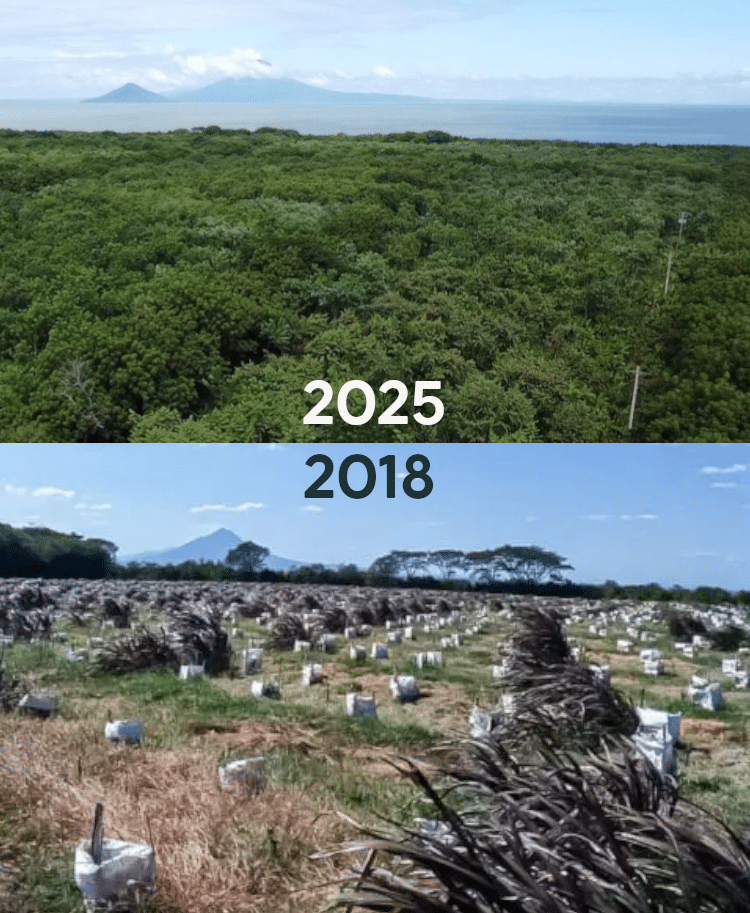
Our regenerative cacao farm in Nicaragua
May 20, 2025
/By Frank Homann, Founder and CEO of Xoco
A model for the future
In the heart of Nicaragua, nestled within a landscape once dominated by cattle pasture, Xoco is pioneering a new vision for agriculture in Central America. Our 100-hectare farm, historically degraded by over a century of intensive grazing, is undergoing a remarkable transformation. This land, once devoid of trees, with depleted topsoil and minimal organic matter, is now emerging as a productive cacao forest thanks to a phased regenerative farming approach.
From Depletion to Regeneration
When we began in 2018, the topsoil was severely compacted, organic matter levels were often below 1%, and the soil’s ability to retain water and nutrients was minimal. This is not uncommon in Central America, where large swathes of land have been cleared for low-output cattle grazing, contributing little to carbon capture and providing marginal economic returns per hectare.
In contrast, our regenerative system is reversing this trend. By planting shade trees, establishing windbreaks, and introducing drip irrigation, we have created microclimates and improved water retention. Organic matter now regularly surpasses 4% in key zones of the farm, dramatically enhancing soil health and enabling the establishment of high-performing cacao trees.
Carbon Capture and Economic Value
Unlike extensive cattle land that sequesters minimal carbon and yields little economic value, a cacao agroforestry system with permanent shade and diverse root structures serves as a carbon sink. Our trees not only draw carbon into the soil but also support biodiversity above and below ground.
Economically, the difference is even more pronounced. A mature hectare of cacao can produce up to 2 tons of dry beans annually. At current market prices ranging between $3 and $10 per kilo—depending on global market prices—this translates into $6,000 to $20,000 in potential revenue per hectare, year after year. This vastly outperforms the economic yield of cattle land.
The Cost and Commitment of Regeneration
The regenerative transition, however, comes at an added cost—approximately 30% more than a conventional development model. This premium reflects the additional time required before production, soil restoration, and investments in systems like shade trees and irrigation.

But this cost is directly tied to long-term productivity. Regenerative land becomes more fertile, more resilient, and more consistently productive over decades. Regenerative development isn’t just a cost of doing business—it’s an investment that increases the underlying value of the land and ensures stronger long-term returns on capital.
Unlocking New Markets for Regenerative Practices
One challenge that remains is monetizing the carbon benefits of regenerative farming at a small to mid-scale level. Most existing carbon markets are designed for large landholdings, often starting at 10,000 hectares or requiring sequestration volumes too high for small farms to achieve individually.
However, private sector solutions are emerging. One promising approach is aggregation, where smaller farms pool their data and outputs to collectively meet the thresholds for verified carbon credits. This model reduces costs for monitoring and certification, making participation in carbon markets feasible.
Additionally, collaborative certification platforms, supply chain partnerships, and impact-driven buyers are opening new avenues to reward farms for regenerative practices, not only through carbon but also through premiums for sustainability and traceability.
A Blueprint for Central America
What we are building is not just a farm; it is a blueprint. Across Nicaragua and Central America, vast areas of underperforming pastureland could be converted into high-yield, carbon-sequestering agroforestry systems. With time and proper investment, these degraded lands can become engines of long-term productivity and profitability.
At Xoco, we believe that regenerative cacao farming is not just viable—it is the rational economic choice for the future of agriculture in the tropics.